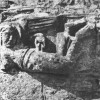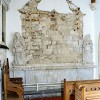Like Dorchester, the county town, Blandford Forum, to give it its full name, recovered within a few years from a disastrous fire that swept through the community three centuries ago. The event is marked in the town with a memorial and fountain protected by Georgian-style stone columns near the parish church of St. Peter and St. Paul. Erected by the Corporation in 1899 the fountain replaced the old pump but the monument still bears the notice that accompanied the original monument erected in 1760:
“In remembrance of God’s dreadful visitation by fire which broke out on the 4th of June 1731 and in a few hours only, reduced the church and almost the whole town to ashes. Fourteen inhabitants perished and two adjacent villages were burned. Blandford has arisen like a phoenix from the ashes, to its present beautiful and flourishing estate.
“This is to prevent by a timely spot of water, with God’s blessing, the fatal consequences of fire hereafter. This monument of that dire disaster and provision against recurral erected 1760.”
After the fire it was a local family of builder-architects, the Bastards, who set about rebuilding the town and its church in a picturesque fashion and in the style of the time, which was Georgian. The church was replaced between 1731 and 1739 and was the work of John Bastard. It was to the church that people brought any belongings they could salvage as their properties were swallowed up by the flames and when the flaming tongues of fire licked at the roof of the church and raced down the nave then it was thought all was lost. Miraculously, the galleries, font, pulpit, some box-pews and the mayoral seat were salvaged from the destruction to be incorporated into the new church.
The original church at Blandford was Norman and succeeded by a 15th century building, but long before that, at the time of the earliest church, Henry the son of William the Conqueror became King Henry l of England and he gave to those Norman barons who supported him, huge estates and manors throughout the country.
Earlier, this area had been held by William de Mortaigne, Count of Mortain, who died around 1140. He was the son of Robert, the half-brother of William I of England, better known as William the Conqueror. William, Count of Mortain did not support his cousin, who became Henry l of England, and he demanded to be given his father’s earldoms of Mortain and Cornwall. In 1103 he returned to Normandy where he openly revolted against Henry I and in 1104 he was captured and imprisoned for many years and stripped of his estates.
Robert de Beaumont, who had fought with William at Hastings in 1066 and whose wife was Isabel, a niece of King Phillip I of France, was given most of Blandford. The Domesday Book reveals his father Roger was the holder of large estates throughout Dorset, including: Stour Provost, Sturminster Marshall, Creech, Steeple, and Church Knowle. His titles included Lord of Brionne. Shaftesbury is twinned with Brionne and Blandford is twinned with Mortain in France.
It is thought the Beaumonts built the first church in Blandford. In 1307 Henry de Lacey, Earl of Lincoln, who had succeeded to the Blandford estates as Lord of the Manor, was given the right to present clergy to the living and the church was acknowledged to have a parish in its own right. Henry Bolingbroke, Duke of Lancaster and at the time Lord of the Manor, became King Henry IV in 1399.
The Rogers family of Bryanston Manor are thought to have contributed to the 15th century church. They owned much of Blandford and were Stewards there for hundreds of years. They had a private chapel in the south aisle of the church and a vault. The north aisle chapel was used by the Ryves family, who were later large landowners.
In 1644, during the Civil War, King Charles I visited Blandford before taking position at the head of his army and marching up Black Lane and over the downs to Cranborne. In the previous century, in 1577 Sir Richard Rogers of Bryanstone is known to have been actively involved in smuggling and piracy off the Dorset coast. It is even suggested that contraband and smugglers were concealed in a vault in Blandford parish church, which was discovered by workmen in 1970.
The Rev. William Alleine resigned his living in 1660 and formed a congregation of Protestant dissenters, but the Established Church was doing well. Blandford Free Grammar school produced five bishops around this time.
How did Blandford get its name? It is suggested from ‘Blaen-y-ford,’ or “the place in front of the ford” as it had a ford on the River Stour (there is no explanation for the Welsh sounding name). Blandford originated because it was at the junction of several trackways and the crossing of the river. These may have been used in prehistoric times.
Bronze and Iron Age finds can be seen at Blandford Museum but there does not seem to have been a Romano-British settlement. The town was given a charter of incorporation in 1605, just a few days after the Guy Fawkes Gunpowder Plot.
In the early 1880’s the church was restored, the organ enlarged, the vestry built, and the peal of eight bells recast. The north wall has memorials to many local families.
Since the earliest times, the Church of Saints Peter and Paul has had over 60 incumbents and still welcomes all who will worship God in His designated house.



